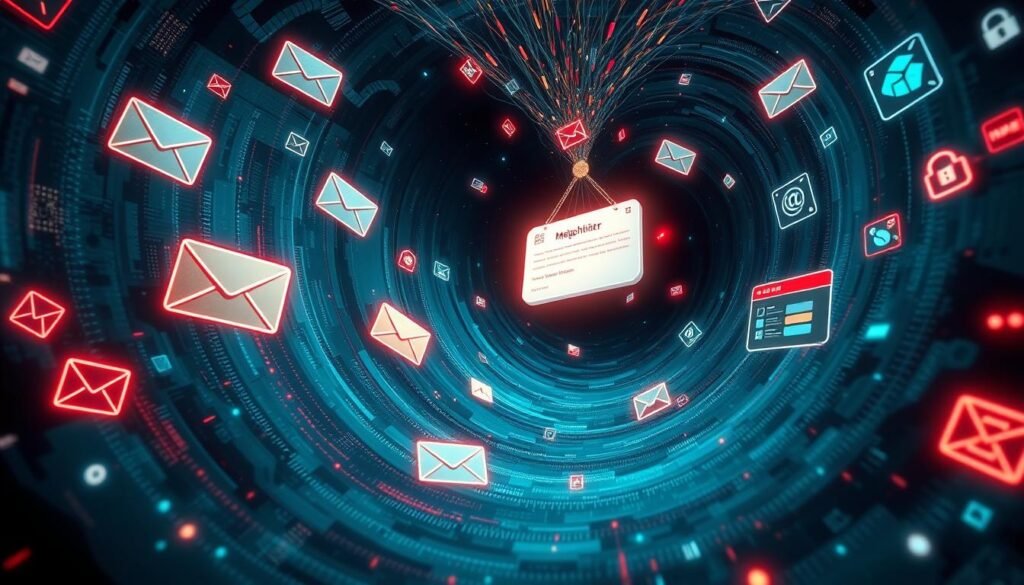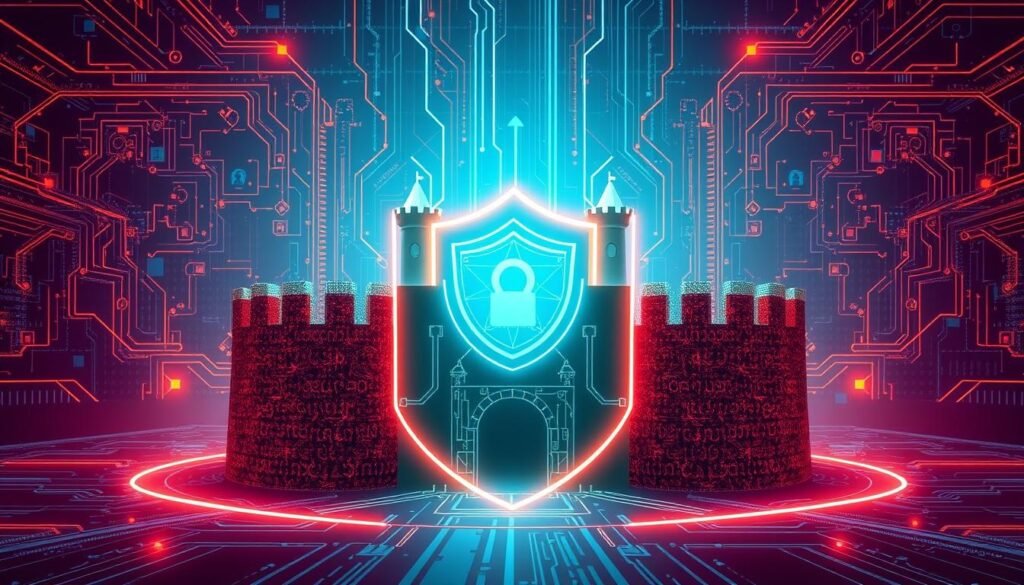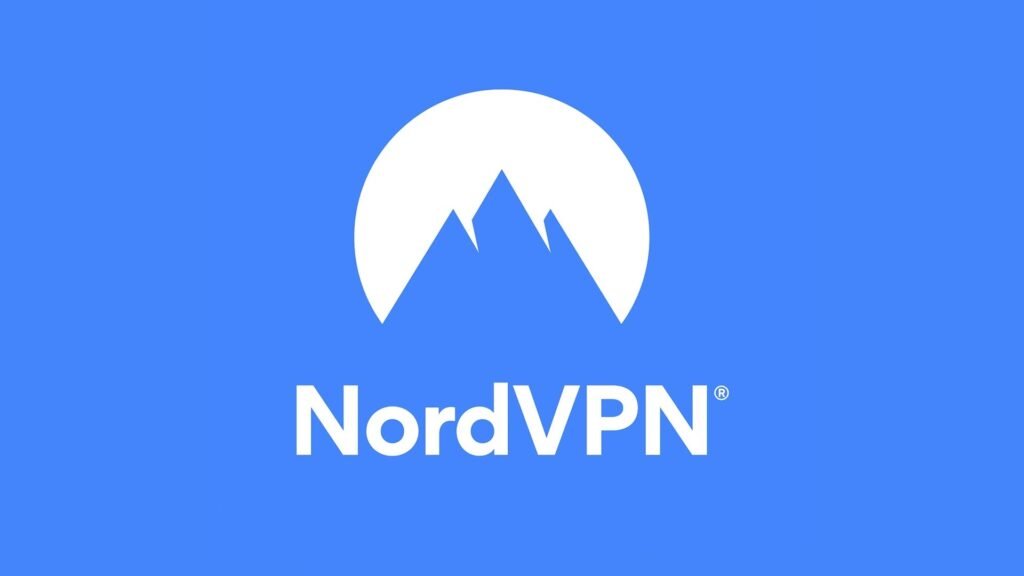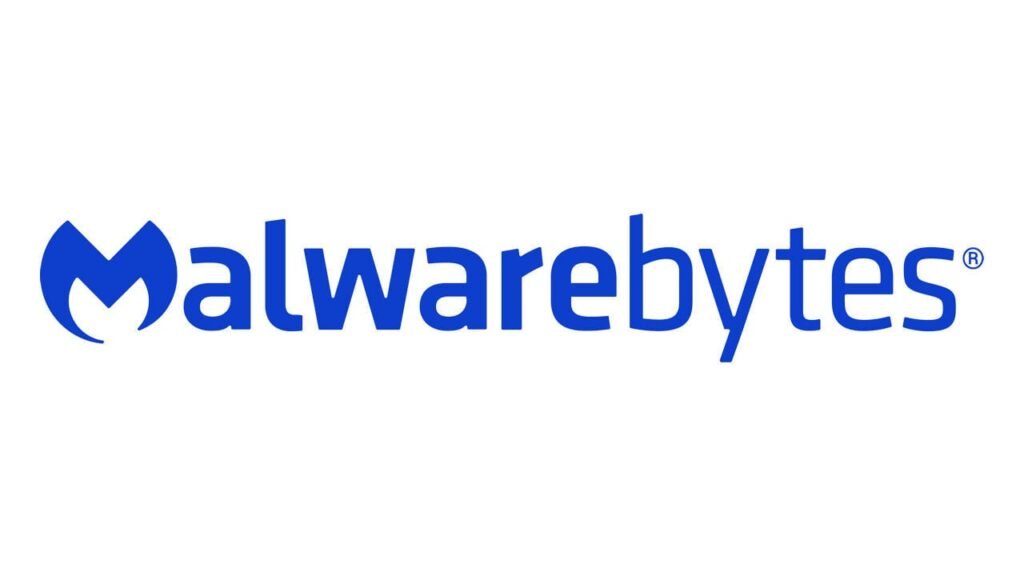Did you know that about 3.4 billion spam emails related to phishing attacks are sent every day? This shows how important it is to know about phishing trends and how to stop them. With new tricks and targets, it's key to keep up with phishing attacks. This article will cover phishing methods, their growth, current numbers, and how to stop them. We'll also talk about how to keep your personal info safe from hackers12.
Key Takeaways
- • Phishing attacks are getting more common, with over 3.4 billion spam emails sent daily.
- • Knowing about cybersecurity and training is crucial for spotting phishing threats.
- • Companies usually don't ask for payment updates via email or text, so be wary of such requests.
- • Using multi-factor authentication greatly boosts protection against phishing.
- • Keeping up with phishing strategies means staying alert and proactive all the time.
Understanding Phishing Attacks
Phishing is a common cyberattack that tricks people and businesses into giving out personal info. It uses fake emails, texts, and calls to look real. Knowing how phishing works helps us stop it and keep our info safe.
Definition of Phishing
Phishing tricks people into sharing private info like passwords or bank details. It's a big problem, causing 16% of all data breaches3. Attackers use tricks to make people act fast, which can put their security at risk.
How Phishing Attacks Work
Phishing starts with lots of emails sent out, hoping some will fall for it. A more targeted version, spear phishing, aims at specific groups. Recently, BEC scams have become popular, making up 49% of spam emails3.
The Evolution of Phishing Tactics
Phishing tactics have changed a lot over time. Cybercriminals keep finding new ways to trick people. They started with simple emails that tried to get personal info from many people at once. These early scams used fake lottery wins to get people's hopes up, making them easy targets in the mid-1990s4.
Early Phishing Techniques
At first, phishing attacks were not very personal. They were like fishing with a wide net, trying to catch as many people as possible. CrowdStrike says phishing is still a big problem today, showing how lasting these old tricks are5.
Rise of Spear-Phishing and Whaling
As technology got better, so did phishing. Spear-phishing started sending emails that seemed to be just for you. This made phishing much more effective. Now, 59% of companies see more mobile phishing attacks because of work-from-home setups5.
Whaling is even more advanced, aiming at top bosses. Scammers pretend to be someone you trust, making their emails seem real. This has led to big losses and security breaches4.
With phones getting more popular, new phishing tricks have come up. There's smishing, vishing, and quishing, all trying to trick phone users. It's important to be careful with messages and keep your phone updated to stay safe4.
Current Trends in Phishing Attacks
Phishing attacks are changing fast, with more happening every day. They target many areas, like voice calls and social media. These are now top ways for hackers to trick people.
Statistics on Phishing Attack Escalation
In early 2024, over 964,000 phishing attacks were spotted. This is a big jump in fake attempts6. Voice and social media phishing made up over a third of these attacks6.
The US was hit the hardest, followed by the UK, Brazil, Turkey, and Russia6. Software and webmail services were hit 21% of the time6.
Top Targeted Sectors and Countries in 2024
Some areas face more threats from hackers. Finance and SaaS are often hit hard, leading to big losses. This shows how important it is to stop phishing attacks7.
In 2024, 80% of phishing aimed at cloud services like Microsoft 365 and Google Workspace8. Also, 64% of businesses faced BEC attacks, losing an average of $150,000 each time8. This highlights the need for strong protection against phishing.

Trends in Phishing Attacks and Ways to Prevent Them
Phishing attacks are getting smarter, so it's key to know how they work. Scammers use emails, spear-phishing, and vishing to trick people or companies. These tactics aim to steal personal info or money.
Common Phishing Attack Methods
Email phishing is a big problem. Scammers send fake emails to make you act fast. They might ask you to click on bad links or open harmful files.
Spear-phishing is a newer trick. It's when scammers send emails that seem real, using info they found online. Now, phishing attacks use AI to reach more people quickly910.
Understanding Email Phishing and Vishing
Vishing is like phishing but over the phone. Scammers pretend to be someone you trust to get your info. It's important to check who's calling before giving out any details.
Both email and phone scams show we need to stay alert. Learning about these threats and how to stop them is crucial910.

| Phishing Method | Characteristics | Preventive Measures |
|---|---|---|
| Email Phishing | Urgent requests, malicious links, attachments | Security awareness training, email filtering |
| Spear-Phishing | Personalized messages targeting specific individuals | Vigilance, employee training on recognizing tailored attacks |
| Vishing | Voice scams attempting to extract sensitive information | Verification of caller identity, awareness campaigns |
Identifying Phishing Attempts
It's key to spot phishing attempts to keep your info safe. Knowing what phishing emails look like and checking URLs helps a lot. This knowledge helps you fight off these sneaky tactics.
Common Characteristics of Phishing Emails
Phishing emails have signs that show they're not real. Look out for:
- • Urgent Language: They try to rush you into action.
- • Generic Greetings: They don't call you by name.
- • Grammar and Spelling Errors: Scams often have mistakes.
- • Requests for Personal Information: Real companies don't ask for this via email.
Knowing these signs helps you avoid falling for phishing. CrowdStrike says scammers send thousands of phishing attacks daily. These can lead to identity theft if you share personal info1112.
Analyzing URLs and Domain Names
It's important to check URLs and domain names carefully. Scammers use fake domains that look almost like real ones. Here's what to look for:
- • Check for Subtle Variations: A small spelling mistake can be a scam.
- • Look for HTTPS: Real sites use HTTPS for secure transactions.
- • Verify the Domain: Make sure the domain matches the company's official site.
If an email seems off, don't click on links. Go straight to the company's website instead. Experts say to check contacts and use multi-factor authentication for better security12.
Phishing Prevention Strategies for Individuals
To protect against phishing attacks, you need to be more aware and educated. Knowing the tricks used by cybercriminals is key to phishing attack prevention. By learning more, you can lower your chances of falling for scams.
Awareness and Education
Learning how to prevent phishing attacks is essential. Phishing is the most common way hackers get into systems13. Every day, millions of phishing attacks happen, so it's important to watch out for them13.
By going to workshops and training, you can learn to spot fake emails. These sessions teach you how to report suspicious emails. They also help you understand how to handle phishing attempts14.
With the right education, you can protect yourself better. This means less harm to your personal and work life.
Utilizing Multi-Factor Authentication
Using multi-factor authentication (MFA) is a big step in phishing attack prevention. MFA makes it harder for hackers to get into your accounts14. Using strong passwords and MFA together keeps your accounts safe from phishing15.
Learning about phishing-resistant methods, like FIDO authenticators, helps keep your info safe15. It's also important to update your security often. This keeps you safe from new phishing tricks.
| Phishing Prevention Strategies | Description |
|---|---|
| Awareness Programs | Training sessions that educate individuals about common phishing techniques. |
| Multi-Factor Authentication | Adding an extra layer of security that requires more than just a password. |
| Regular Software Updates | Keeping your operating system and applications up to date to reduce vulnerabilities. |
| Email Filtering | Using advanced email filters to flag potential phishing attempts before they reach your inbox. |
| Incident Reporting | Reporting suspicious emails or activity to help organizations protect against future attacks. |
By staying informed and using these strategies, you can better protect yourself from phishing attacks in your daily life14.
Organizational Measures for Phishing Defense
Organizations must stay ahead of phishing attacks to protect their assets. Advanced threat protection is crucial in this fight. Technologies like AI-driven email scanning help block sophisticated phishing emails16.
Regular monitoring systems also help by alerting to potential threats. This reduces the risk of falling victim to phishing attempts.
Implementing Advanced Threat Protection
Advanced threat protection solutions are a strong defense against phishing. Cybercriminals use professional marketing to make phishing emails look real17. Automated systems watch email traffic and suspicious activity to keep defenses up.
It's important to update these systems often to fix any weaknesses hackers might find.
Regular Training for Employees
Employees are the first line of defense against phishing. Training them to spot and report phishing is key. Awareness programs teach them to look out for signs like unusual greetings or urgent requests16.
Teaching them to check email addresses and hover over links helps too. This makes them better prepared for new phishing tactics.
Creating a culture of cybersecurity awareness is important. With phishing attacks on the rise, ongoing training is essential18. Keeping everyone vigilant is crucial for protecting against cyber threats.
Tools and Resources for Phishing Prevention
To fight phishing attacks, it's key to use the right tools and resources. Both individuals and organizations need to stay ahead of phishing threats. This means using digital risk protection platforms and phishing detection services. These tools help strengthen your defenses and reduce risks.
Digital Risk Protection Platforms
Digital risk protection platforms are vital for phishing attack prevention. They check domain registrations for threats and watch the web for suspicious activity. In 2022, Kaspersky blocked nearly 508 million phishing emails, showing how important these tools are19. They also alert you to new phishing schemes, so you can act fast.
Phishing Detection Services
Adding phishing detection services to your cybersecurity is crucial. These services use advanced tech to spot and block phishing messages20. Phishing was the top cyberattack in 2020, making these services even more important21. Using multi-factor authentication with these services can greatly reduce the damage from stolen credentials. Also, training and phishing simulations can improve how employees handle phishing attacks.
Conclusion
It's key to know about phishing trends to protect ourselves. Phishing is a big cybercrime problem, causing billions in losses. It's urgent to improve our online safety22.
Recently, phishing attacks have gone up by 58.2% each year. New tricks like deepfake and AI voices make old defenses weak22.
To fight phishing, we need better education and tech. Most phishing comes through email. So, teaching your team to spot fake emails is crucial23.
Staying updated is our best defense against phishing. By learning and acting fast, we can keep our data safe. For more tips, check out this link on cybersecurity.




